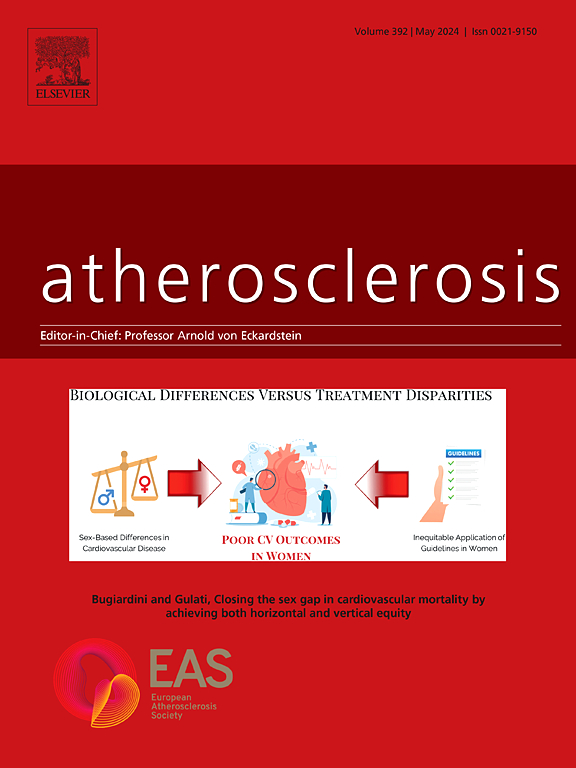Pressure- and flow-driven biomechanical factors associate with carotid atherosclerosis assessed by computed tomography angiography
IF 5.7
2区 医学
Q1 CARDIAC & CARDIOVASCULAR SYSTEMS
引用次数: 0
Abstract
Background and aims
Local biomechanical factors are known to influence atherosclerosis in extracranial carotid arteries. While the role of some flow-driven biomechanical factors has been investigated, the influence of pressure-driven mechanical wall stress (MWS) has received limited attention. In this study, the association of the pressure-driven and flow-driven biomechanical factors with carotid atherosclerosis was examined.
Methods
Carotid arteries (n = 150) with mild-to-moderate stenosis from 75 symptomatic patients (Plaque-At-Risk study) were imaged using multi-detector computed tomography angiography (MDCTA) at the time of inclusion and after 2 years. Structural changes in carotid wall and calcifications were quantified from MDCTA data while the local baseline biomechanical factors in the carotids were determined using fluid-structure interaction (FSI) computational models. The associations of the local pressure-driven and flow-driven biomechanical factors with the carotid wall and calcification changes were studied using Generalized Linear Mixed models.
Results
Over two years, plaque sectors, with calcified and non-calcified sectors combined, exhibited minimal change in wall thickness, likely due to medical treatment. High MWS was associated (p < 0.001) with a reduction in plaque thickness. In calcified plaque sectors, high MWS and low oscillatory shear index (OSI) were associated (p < 0.001) with greater calcification thickness increase. The distance between the lumen and calcification decreased over time, especially in the sectors exposed to high time-averaged wall shear stress (TAWSS) and high MWS.
Conclusions
Our results suggest that the pressure-driven local MWS and flow-driven OSI and TAWSS significantly correlate with the development of calcified and non-calcified plaques in carotid arteries.
Registration
URL: https://www.clinicaltrials.gov; Unique identifier: NCT01208025.

通过计算机断层血管造影评估与颈动脉粥样硬化相关的压力和血流驱动的生物力学因素。
背景和目的:局部生物力学因素可影响颅外颈动脉粥样硬化。虽然一些流动驱动的生物力学因素的作用已经得到了研究,但压力驱动的机械壁应力(MWS)的影响却很少得到关注。在这项研究中,研究了压力驱动和血流驱动的生物力学因素与颈动脉粥样硬化的关系。方法:从75例有症状的患者(斑块-危险研究)中选取150例轻度至中度狭窄的颈动脉(n = 150),在纳入时和2年后使用多探测器计算机断层扫描血管造影(MDCTA)对其进行成像。通过MDCTA数据量化颈动脉壁和钙化的结构变化,同时使用流固相互作用(FSI)计算模型确定颈动脉局部基线生物力学因素。采用广义线性混合模型研究局部压力驱动和血流驱动的生物力学因素与颈动脉壁和钙化变化的关系。结果:两年多来,钙化和非钙化斑块的壁厚变化很小,可能是由于药物治疗。结论:我们的研究结果表明,压力驱动的局部MWS和血流驱动的OSI和TAWSS与颈动脉钙化和非钙化斑块的发展显著相关。注册:网址:https://www.Clinicaltrials: gov;唯一标识符:NCT01208025。
本文章由计算机程序翻译,如有差异,请以英文原文为准。
求助全文
约1分钟内获得全文
求助全文
来源期刊

Atherosclerosis
医学-外周血管病
CiteScore
9.80
自引率
3.80%
发文量
1269
审稿时长
36 days
期刊介绍:
Atherosclerosis has an open access mirror journal Atherosclerosis: X, sharing the same aims and scope, editorial team, submission system and rigorous peer review.
Atherosclerosis brings together, from all sources, papers concerned with investigation on atherosclerosis, its risk factors and clinical manifestations. Atherosclerosis covers basic and translational, clinical and population research approaches to arterial and vascular biology and disease, as well as their risk factors including: disturbances of lipid and lipoprotein metabolism, diabetes and hypertension, thrombosis, and inflammation. The Editors are interested in original or review papers dealing with the pathogenesis, environmental, genetic and epigenetic basis, diagnosis or treatment of atherosclerosis and related diseases as well as their risk factors.
 求助内容:
求助内容: 应助结果提醒方式:
应助结果提醒方式:


